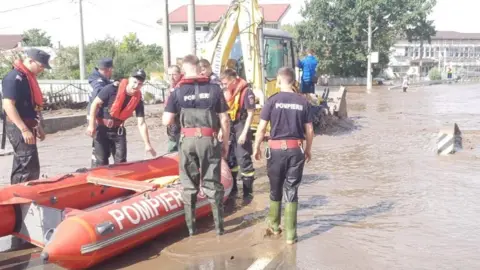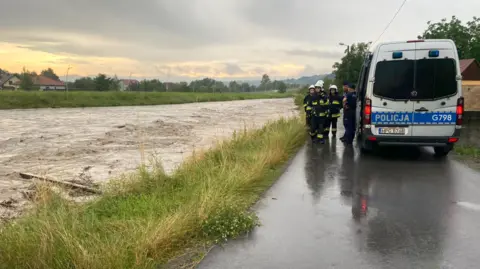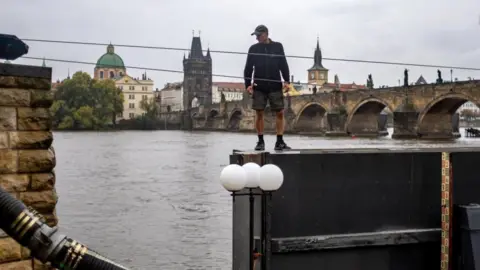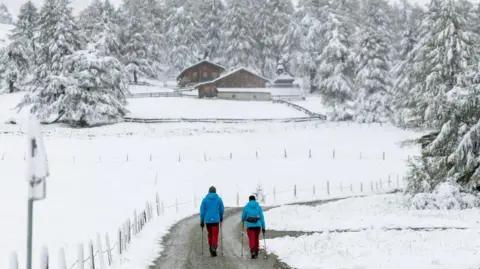 Reuters
ReutersFour people have died in Romania due to floods caused by torrential rain sweeping through central and eastern Europe, emergency services have said.
Elsewhere on Saturday, the highest flood alert was declared in 38 locations across the Czech Republic.
In the capital Prague, the city’s flood barriers have been raised, embankments have been closed to the public, and the zoo has been closed, Czech authorities said.
Evacuations have also started in Poland as rivers rise to dangerous levels.
The four dead people were found in the southeastern Romanian region of Galati during a search and rescue operation, emergency services confirmed to the AFP news agency.
“Dozens of people were rescued from their homes in 19 areas of the country,” they added.
 Polish Police
Polish PoliceIn Poland, Interior minister Tomasz Siemoniak said residents in the small towns near the Czech border of Morow and Glucholazy, were facing a dangerous situation.
In the Glucholazy the river level had exceeded a safe level by two metres and residents living in nearby streets have been evacuated.
“The situation looks very bad. The state of the river and the forecasts about its state are still bad,” Mr Siemoniak said.
“We have a difficult situation in four rivers, potentially threatening evacuations and damage in several towns,” he added.
Since Thursday, Cyclone Boris has brought strong winds and torrential rain to parts of Poland, Austria, the Czech Republic, Hungary, Romania and Slovakia.
The Czech capital is taking no chances, after floods that devastated the city two decades ago.
Images from 2002 of flooded metro stations, residents being evacuated in rubber dinghies and elephants drowning in the Prague Zoo are seared into the local memory.
Shortly before 10:00 (08:00 GMT) on Friday, a heavy steel gate, one metre thick, closed off the so-called Devil’s Canal or Certovka, a sliver of water that slices through the historic Mala Strana district of Prague before rejoining the River Vltava.
 MARTIN DIVISEK/EPA-EFE/REX/Shutterstock
MARTIN DIVISEK/EPA-EFE/REX/ShutterstockThe Certovka gate is part of a nationwide network of flood defences that officials say have cost more than €1bn (£845m) in order to prevent a repeat of the catastrophic damage of 1997 and 2002.
Prague hopes to escape the worst of the flooding. Attention is focused this weekend on central and eastern parts of the country, especially North Moravia, where 50 people lost their lives in 1997.
The Jeseniky mountains could receive some 400mm over the next three days, and that water will then cascade down the River Oder (Odra in Czech) and on towards Poland, passing a number of towns and villages on the way.
 GeoSphere Austria
GeoSphere AustriaAfter attending a briefing by emergency services in south-west Poland, Donald Tusk sought to reassure the public that the forecasts were “not overly alarming” and there was no reason to predict anything on a scale that might cause a threat across the country.
Poland’s territorial army was on standby, he said, and in one of the four southern provinces, Malopolska, an estimated two million sandbags had been stockpiled, while another million were available in Lower Silesia, the province around Wroclaw.
“If something can be expected, and this what we want to be prepared for, it is of course localised flooding or so-called flash floods,” he added.
Thousands of residents had to use the staircases of their high-rise blocks of flats in Wroclaw, because the lifts were shut down amid flooding fears, local media reported.
The Polish Institute of Meteorology and Water Management later extended the highest alert level from the four southern provinces to the mouth of the River Odra in Szczecin, where it spills into the Baltic Sea.
Austria experienced its hottest August since records began, according to the Geosphere Austria federal institute.
Now it is warning of 10-20cm of rainfall in many regions in a matter of days. In some places, well over 20cm is possible, especially in the mountains of Upper and Lower Austria and in northern Upper Styria.
 JOHANN GRODER/APA/EXPA/AFP
JOHANN GRODER/APA/EXPA/AFPAustrian storm warning centre UWZ says that in some areas, previous records for the entire month of September will be “surpassed in just a few days”.
Manuel Kelemen, a forecaster for Puls24 TV, says from a meterological point of view, “what we’re experiencing is extraordinary, if not unprecedented”.
Railway network OEBB has advised all passengers to postpone non-urgent journeys. Part of the Tauern railway line between Bad Hofgastein and Böckstein in the province of Salzburg has been closed because of heavy snowfall.
Flooding and landslides are possible, with gale force winds expected in the capital, Vienna. Aid organisation Caritas has appealed for volunteers to help in affected areas.
Continuous heavy rain is also expected across the border in the German state of Bavaria.
This is of course a regional, not a national emergency, with a large area of Central Europe affected.
But a reminder of national priorities came earlier this week when Czech officials said they had been forced to refuse a German request to stop emptying reservoirs into the River Vltava, which flows into the River Elbe (Labe in Czech) and onwards to Germany, following the collapse of a bridge in Dresden.
Those reservoirs – a series of nine dams known as the Vltava Cascade – will need to be half-empty to take what this weekend has in store.
Extreme precipitation is becoming more likely in Europe, as across much of the world, due to climate change.
A warmer atmosphere can hold more moisture, which can lead to heavier rainfall.
